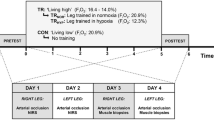Abstract
The purpose of this study was to test the hypothesis that work-induced skeletal muscle hypertrophy may be reduced by training in chronic hypobaric hypoxia compared to normoxia. Five healthy males [mean age 34.4 (SEM 2.2) years] performed strength training of the elbow flexors for 1 month, at altitude (A) (5050 m) and with the same absolute loads at sea level (SL), 8 months later. The EF cross-sectional area (CSA), determined at mid-arm by nuclear magnetic resonance imaging, increased by 11.3 (SEM 3.7)% (P < 0.05) at A and 17.7 (SEM 4.5) % (P < 0.05) at SL. Isometric maximal voluntary contraction (MVC) increased by 9.5 (SEM 2.6)% (P<0.05) at A and 13.6 (SEM 2.4)% (P<0.05) at SL. The CSA and MVC changes in A were significantly smaller than at SL (P<0.05). Muscle specific tension did not change in either condition. No changes in muscle plus bone or MVC of the untrained, controlateral arm were observed. Thus, although there was no indication of muscle wasting at A, the hypertrophic response of skeletal muscle when trained in chronic hypoxia seemed to be significantly lower than that produced in normoxia. This effect could have arisen either from a direct depression of protein synthesis and/or hormonal changes provoked by hypoxia.
Similar content being viewed by others
References
Blume FD, Boyers SJ, Braverman LE, Cohen A, Dirkse J, Mordes JP (1984) Impaired osmoregulation at high altitude. Studies on Mt. Everest. J Am Med Assoc 252:254–256
Cerretelli P, di Prampero PE (1985) Aerobic and anaerobic metabolism during exercise at altitude. Med Sport Sci 19:1–19
Durnin VGA, Womersley J (1974) Body fat assessed from total body density and its estimation from skinfold thickness: measurements on 481 men and women aged from 16 to 72 years. Br J Nutr 32:77–97
Ferretti G, Hauser H, di Prampero PE (1990) Maximal muscular power before and after exposure to chronic hypoxia. Int J Sport Med 11: S31-S34
Garner SH, Sutton JR, Burse RL, McComas AJ, Cymerman A, Houston CS (1990) Operation Everest II: neuromuscular performance under conditions of extreme simulated altitude. J Appl Physiol 68:1167–1172
Goldberg AL, Etilinger JD, Goldspink DF, Jablecky C (1975) Mechanism of work-induced hypertrophy of skeletal muscle. Med Sci Sports Exerc 7:248–261
Goldspink G (1992) Cellular and molecular aspects of adaptation in skeletal muscle. In: Komi PV (ed) Strength and power in sports. Blackwell, Oxford, pp 211–229
Green HJ, Sutton JR, Wolfel EE, Reeves JT, Butterfield GE, Brooks GA (1992) Altitude acclimatization and energy metabolic adaptations in skeletal muscle during exercise. J Appl Physiol 73:2701–2708
Hoppeler H, Schena F, Turner DL, Vock P (1990) Changes in upper arm cross-sectional area with short-term endurance training in humans. J Physiol 423:87P
Jones PRM, Davies PSW, Norgan NG (1986) Ultrasonic measurements of subcutaneous adipose tissue thickness in man. Am J Phys Anthrop 71:359–363
Kayser B (1992) Nutrition and high altitude exposure. Int J Sports Med 13:S129-S132
Kayser B, Acheson K, Decombaz J, Fern E, Cerretelli P (1992) Protein absorption and energy digestibility at high altitude. J Appl Physiol 73:2425–2431
Kawakami Y, Nakazawa K, Fujimoto T, Nozaki D, Miyashita M, Fukunaga T (1994) Specific tension of elbow flexor and extensor muscles based on magnetic resonance imaging. Eur J Appl Physiol 68:139–147
MacDougall JD, Elder GCB, Sale DG, Moroz JR, Sutton JR (1980) Effects of strength training and immobilisation on human muscle fibres. Eur J Appl Physiol 43:25–34
MacDougall JD, Green HJ, Sutton JR, Coates G, Cymerman A, Young P, Houston CS (1991) Operation Everest II: structural adaptations in skeletal muscle in response to extreme simulated altitude. Acta Physiol Scand 141:421–427
McDonagh MJN, Hayward CM, Davies CTM (1983) Isometric training in human elbow flexor muscles. J Bone Joint Surg 65:355–358
McKinnon PCS, Monk-Jones ME, Fotherby K (1963) A study of various indices of adrenocortical activity during 23 days at high altitude. J Endocrinol 26:555–566
Mordes JP, Blume FD, Boyers S, Zheng MR, Braverman LE (1983) High altitude pituitary-thyroid disfunction on Mt. Everest. N Engl J Med 308:1135–1138
Morrison WL, Gibson JNA, Scrimgeour C, Rennie MJ (1988) Muscle wasting in emphysema. Clin Sci 75:415–420
Orizio C, Esposito F, Veicsteinas A (1994) Effect of acclimatization to high altitude (5050 m) on the motor unit activation pattern and muscle performance. J Appl Physiol 77:2840–2844
Preedy VR, Smith DM, Sugden PH (1985) The effects of 6 hours hypoxia on protein synthesis in rat tissues in vivo and in vitro. J Biochem 228:179–185
Rennie MJ, Babij P, Sutton JR, Tonkins WJ, Read WW, Ford C, Halliday D (1983) Effects of acute hypoxia on forearm leucine metabolism. In: Sutton JR, Houston CS, Jones NL (eds) Hypoxia, exercise and altitude. Liss, New York, pp 317–323
Rutherford OM, Jones DA (1986) The role of learning and coordination in strength training. Eur J Appl Physiol 55:100–105
Sutton JR, Viol GW, Gray GW, McFadden MD, Keane PM (1977) Renin, aldosterone, electrolyte, and cortisol responses to hypoxic decompression. J Appl Physiol 43:421–424
Sutton JR, Mills KR, Cobley AJ, Jones DA, Edwards RHT (1983) The effect of acute hypoxia on muscle fatigue. In: Sutton JR, Houston CS, Jones NL (eds) Hypoxia, exercise and altitude. Liss, New York, pp 478
Thepaut-Mathieu C, Hoecke J, Maton B (1988) Myoelectrical and mechanical changes linked to length specificity during isometric training. J Appl Physiol 64:1500–1505
Young A, Stokes M, Round JM, Edwards RHT (1983) The effect of high resistance training on strength and cross-sectional area of the human quadriceps. Eur J Clin Invest 13:411–417
Young PM, Rose MS, Sutton JR, Green HJ, Cymerman A, Houston CS (1989) Operation Everest II: plasma lipid and hormonal responses during a simulated ascent of Mt. Everest. J Appl Physiol 66:1430–1435
Author information
Authors and Affiliations
Rights and permissions
About this article
Cite this article
Narici, M.V., Kayser, B. Hypertrophic response of human skeletal muscle to strength training in hypoxia and normoxia. Eur J Appl Physiol 70, 213–219 (1995). https://doi.org/10.1007/BF00238566
Accepted:
Published:
Issue Date:
DOI: https://doi.org/10.1007/BF00238566




